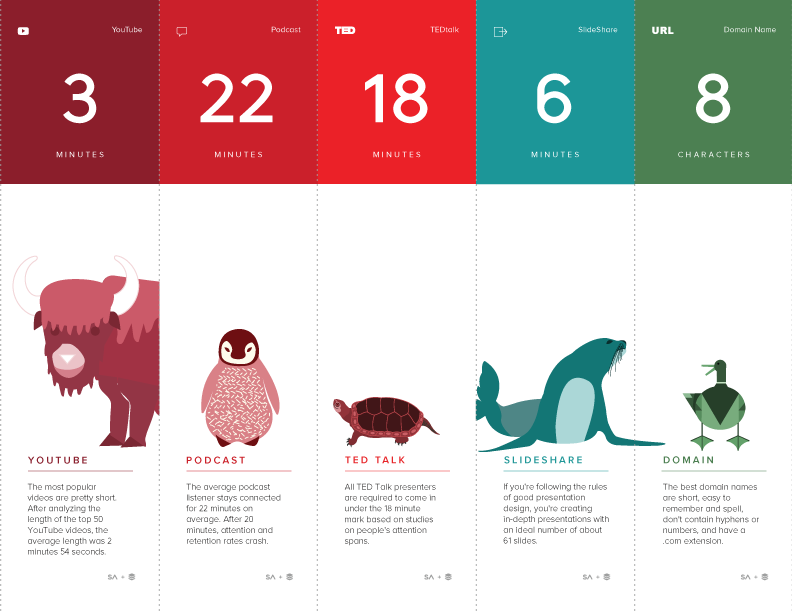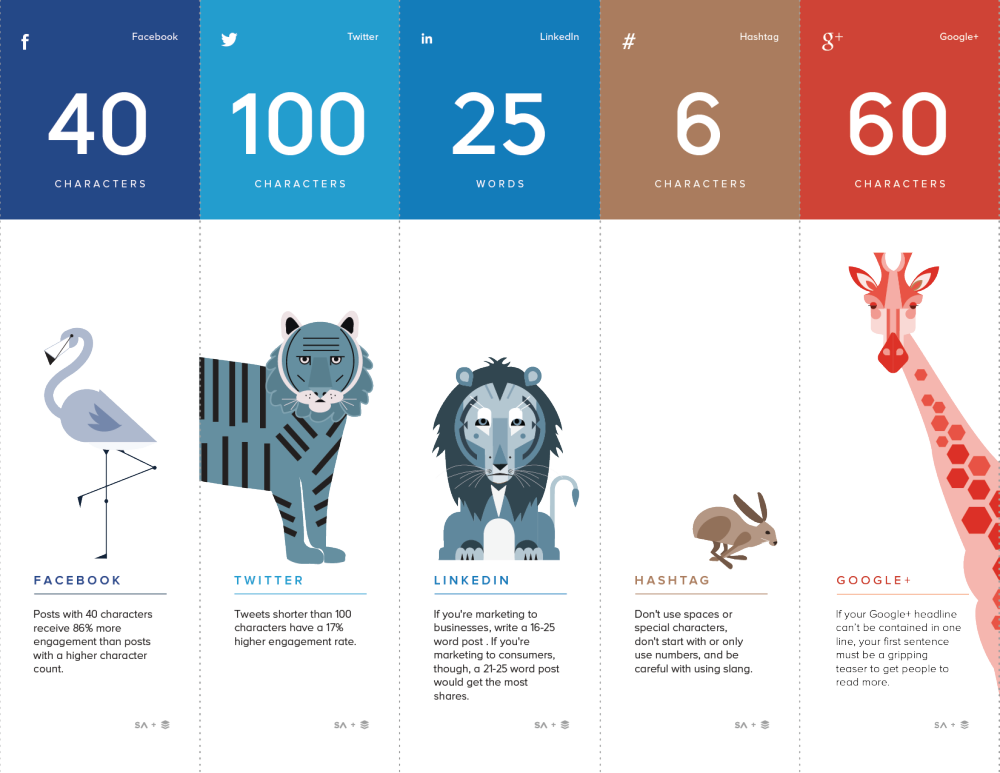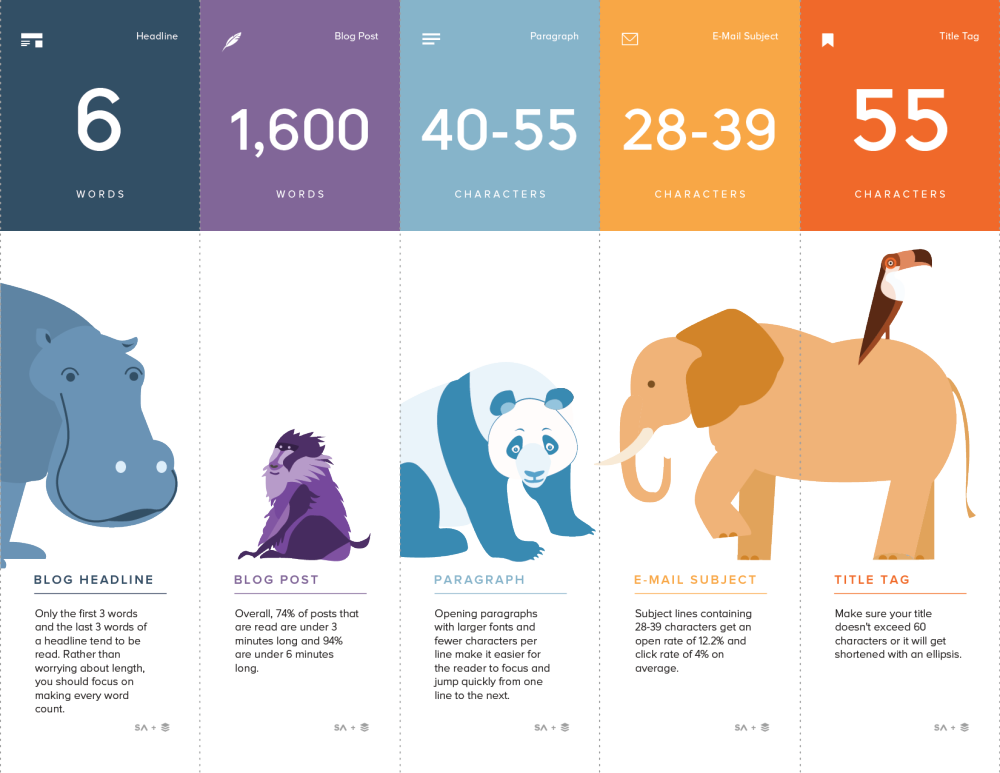This post come from the-ideal-length-of-everything-online-according-to-science
and their updater
How long should my tweet be? Or my blogpost? Or my headline?




It seems like people love to be told what works best. They love to have a starting point.
- The optimal length of a tweet — 71 to 100 characters
Not only does this length give you enough room to share your message, it also provides room for someone who retweets you to add a message of their own.
What makes this length optimal?
Tweets at this length get more retweets. They also have higher reply rate, retweet rate, and combined reply/retweet rate. - The optimal length of a Facebook post – 40 characters
Shorter seems to be better on Facebook.
Maximum engagement happens at 40 characters (so, too, does minimum quantity, meaning that a vast minority of Facebook posts hit this 40-character mark). And engagement slowly wanes the longer you go.
An 80-character post is better than 100-character post.
A 40-character post is better than 80.
What makes this length optimal?
Posts at this length tend to receive higher like rate, comment rate, and combined like/comment rate (stats that include a comparison of total engagement to number of Facebook fans.) - The optimal length of a Google+ headline – 60 characters maximum
Google+ updates often take on the appearance of blogposts with bold headings up top and a body of text below. These top headings are the ones you’re best off optimizing. And 60 characters is as long as you should go.
What makes this length optimal?
It’s the maximum length for a Google+ headline to span one row before breaking to a second line. - The optimal width of a paragraph – 40 to 55 characters
usability studies and psychology suggest that they notice it.
What makes this width optimal?
At this width, the content appears simple to understand, and readers feel they can comprehend the subject matter. The optimal length of a domain name – 8 characters
What characteristics do some of the best domain names have in common?- is short
Length, in particular, can be a tough one to nail down as dot-coms get snatched up so quickly. If you can’t secure the dot-com of your dreams, there are more and more websites going the route of .co and .io. - is easy to remember
- is easy to spell
- is descriptive or brandable
- does not contain hyphens and numbers
- has a .com extension
What makes this length optimal?
This is the most common domain name length for the Internet’s most popular websites.- is short
- The optimal length of a hashtag – 6 characters
What makes this length optimal?
The 6-character hashtag recommendation comes from a handful of Twitter experts and is cited by Hashtags.org, one of the leading sites on the data and usage of hashtags. - The optimal length of an email subject line – 28 to 39 characters
Clearly, there are a ton of different ways to approach writing a subject line, and length is equally as important to test as the rest of the elements. If you’re looking for a place to start your tests, the optimal length of 28 to 39 characters is a good bet.
What makes this length optimal?
You may see a slight uptick in open rate and click rate at this length.
Where’d this data come from?
A 2012 study by Mailer Mailer looked at 1.2 billion email messages to identify subject line trends. - The optimal length of an SEO title tag – 55 characters
SEO titles are the titles of your webpages and blogposts that show up in search results.
What makes this length optimal?
Google search results tend to truncate titles with an ellipsis (…) if they go beyond the 55-character mark. - The optimal length of a blog headline – 6 words
What makes this length optimal?
Our eyes tend to pick up on the first three words of a headline and the last three words. - The optimal length of a LinkedIn post – 25 words
The results on optimal LinkedIn length depend on whom you’re targeting. Are you trying to reach out to businesses or consumers?
What makes this length optimal?
The results in the Compendium study tend to focus on clickthroughs as the basis for recommending best practices. It’s safe to assume an ideal length of a LinkedIn post would be based on clicks, too. The optimal length of a blogpost – 1,600 words
What makes this length optimal?
At this length, you can expect readers to spend the maximum amount of time reading your content. Total time on page is highest at the 1,600-word length than any other length.
From the Medium study:7-minute posts capture the most total reading time on average.
The optimal length of a YouTube video – 3 minutes
How much time do you get to tell your story in a video? How long until someone loses interest and clicks over to the next link? These are big questions for video marketers who compile their content with timestamps in mind the same way bloggers compose with word count.
What makes this length optimal?
This is the average video length of the top videos on YouTube.- The optimal length of a podcast – 22 minutes
Podcasting has become more and more a part of content marketing strategies for brands big and small. There are sure to be additional studies that come out on best practices for publication and promotion.
In the meantime, optimal length is a good place to start. Keep things 22 minutes or shorter.
What makes this length optimal?
The 22-minute mark is when an average user disconnects from a podcast. - The optimal length of a presentation – 18 minutes
Famously, the 18-minute mark is where TED Talks max out their presenters. Anyone who shares must stay under 18 minutes.
Here’s why.
What makes this length optimal?
This seems to be the upper limit for how long a person can pay attention before losing focus. The optimal length of a SlideShare – 61 slides
You’d think that SlideShare best practices would be cut-and-dry. My research wasn’t quite so clear.
The 61-slide recommendation comes from HubSpot’s Dan Zarella who is well-known for his in-depth and accurate research on social media. From a data-backed perspective, 61 slides seems like a safe way to go.We can only speculate about why this is true, but it may be owed to the fact that SlideShare is a site mostly used by professionals who are likely seeking data-focused, meaty presentations with a lot of depth. Don’t be afraid to get detailed in your SlideShare content, and load your presentations with lots of data. Unlike YouTube, where shorter content tends to be more successful, SlideShare users welcome comprehensive content.
Here’s the breakdown of number of slides per presentation and SlideShare views, courtesy of Dan.
Beyond the data, there is a bit of opposite advice that many hold as a best practice: Guy Kawasaki’s 10/20/30 rule.- 10 Slides
- 20 Minutes
- 30 Point Font
It’s a system that a lot of people swear by. Is it right for you? There’s only one way to find out, and that’s by testing.
What makes this length optimal?
Slide decks of this length get more views on average.The optimal size of a Pinterest image – 735px by 1102px
Curalate found that vertical images, featuring an aspect ratio between 2:3 and 4:5, receive 60 percent more repins than images with a more vertically-skewed aspect ratio.
Combine this with the best practices from the folks at Canva who recommend a starting point for Pinterest image templates at 735 pixels wide by 1102 pixels tall and—bang!—you’ve got your ideal size, backed by data.
What makes this size optimal?
At this size, you can expect more likes, repins, and commentsConclusion
Hopefully you’ve found some good insights from this experiment.
Definitely use data like this as a starting point for your own testing and iterating.
What’s right for many others in terms of best practices might not be exactly what your specific audience needs.
It sure is nice to know where to start, though.
I’d love to see if I can help make it even more useful.